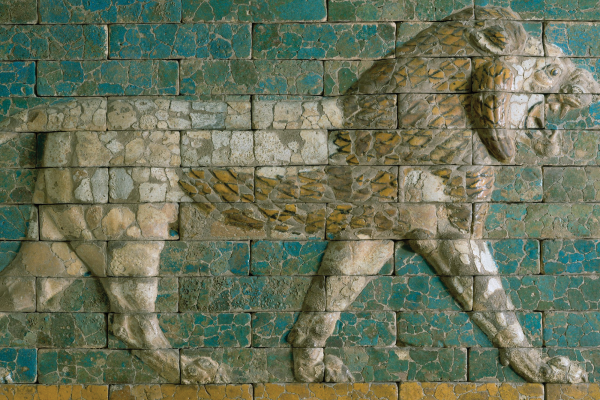THIS ISN'T A lion: It’s a miracle. You can almost hear the imperious growls that would have thundered in the imaginations of pedestrians approaching ancient Babylon’s Ishtar Gate. They would have walked along the Processional Way to enter the inner city, flanked by cerulean blue tile walls with 120 nearly life-sized lion bas-reliefs—a spectacle!
Not so in 1899, when German archaeologists arrived on the banks of the Euphrates—80 miles from Baghdad—and dug until 1917. Babylon’s splendor had been reduced to mounds of thousands of glazed brick fragments, which would fill nearly 800 crates sent to Berlin. There, each piece was laboriously cleaned, stabilized with modern material, sorted and assembled into whole bricks, and ultimately restored into panels of proudly parading beasts in Berlin’s Pergamon Museum. Iraq has been trying to get them back since the 1990s.
For nearly two centuries the Greeks and the British have been arm wrestling over the Parthenon Marbles—including a lengthy frieze of a mythical Greek feast, a muscled river god, and voluptuous female figures—taken from the Acropolis in Athens and now displayed in London’s British Museum. Lord Elgin was Britain’s ambassador to the Ottoman Empire, which encompassed Greece. Greece claims that Lord Elgin stole them, that the sale was illegitimate since Greece was occupied, and that they should be returned.
The British Museum counters that its collections represent the complexity and richness of the whole world, accessible for free to 6 million international visitors annually, and also that, by law, they cannot break up collections. However, it will consider requests to borrow them—a stark contrast to the frequent advice of the independent British committee that monitors the export of art and cultural objects, which usually wants to keep them in the U.K. Greece is celebrating its 200th anniversary of independence in 2021 and has formally submitted a request.
A seemingly infinite number of “items” from formerly colonized parts of the world have been removed to institutions and collectors around the world. Taken with them? Transgenerational identity, memory, knowledge, ritual, inspiration, self-esteem—even agency, given that their owners were powerless to stop the theft. Are they still?
A case in point: The famed Benin Bronzes of the ancient Kingdom of Benin (located in present-day southern Nigeria) were looted in 1897 by a British expeditionary force. In a passionate op-ed published earlier this year in The New York Times, Nigerian artist Victor Ehikhamenor—who formed an art installation out of statuettes made by modern bronze casters in Benin City, the former capital of the Kingdom of Benin—wrote: “Generations of Africans have already lost incalculable history and cultural reference points because of the absence of some of the best artworks created on the continent. We shouldn’t have to ask, over and over, to get back what is ours.”
In the works for 10 years, the current Benin royal family and Nigerian local and national governments plan to open a museum in Benin City in 2023, with at least 300 bronzes coming from collections of 10 major European museums, including the British Museum. Initially, artifacts will be loaned for three years with possible renewal or replacement upon expiration—but not restituted.
A report commissioned a few years ago by French President Emmanuel Macron indicated items looted by the nation during the colonial era should be returned to their countries of origin. Macron pledged to return artifacts seized from the Kingdom of Dahomey (located in what is now the country Benin) by 2021. The transition has been slow in coming, however, and French cultural institutions question whether African counterparts have the infrastructure to provide proper shelter and care.
Yet another layer, some Africans protest, of colonial condescension.

Got something to say about what you're reading? We value your feedback!





